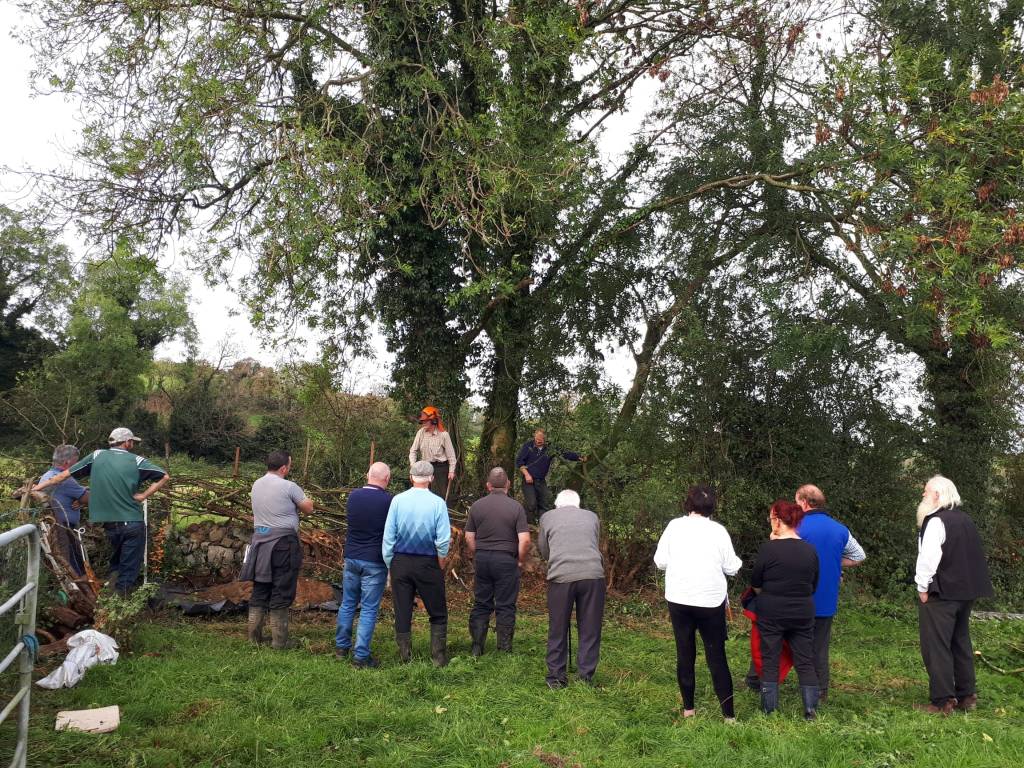Recent Experience from Martin Burns Farm, Castleblayney.
A group of farmers recently attended a hedge management course at Martin Burns farm, Castleblayney. The training was provided by John McKeon of the Irish Wildlife Trust (Monaghan Branch). Farmers are very familiar with the concept of management as they look after their crops and animals. Sadly in our busy modern era, this care and attention rarely extends to the hedges on the farm. As the group arrived there was talk of the weather, the poor price of farm produce and the high cost of inputs but nere a mention of hedges.

Attendees at the demonstration near Castleblayney
The background to our hedgerows
Field hedges were planted by tenant farmers on instruction of their landlords to enclose areas of common lands into defined areas or fields. Whitethorn quicks were mostly used to create these new field boundaries hedges. Whitethorn, also known as hawthorne are fast growing, recover well from clipping and produce a stock proof hedge because of thorns. However they are short lived relative to other trees as decay and rot can set in 60 years after planting. While they can remain partially alive for many years, they will eventually die leaving gaps in the hedges. If this be so, then why have all the old hedges not died out over hundreds of years? It all depends on how hedges were managed over the centuries. Pre 1960, most field hedges were coppiced on a cyclical basis around the farm.
Hedges were cut to ground level to extract heavy timber for cooking and home heating. Whitethorn responds very well to coppicing by growing up new shoots from ground level which in effect produces a new hedge and starts the clock again. The new sprouts make full use of the existing root structure left behind after coppicing and so quickly stretches upwards.

Martin and John laying a stem
Making Hedge Management Work
The old farming method of crop rotation made good hedge management easier. Good stock proof hedges were vital when fields were in grass and grazed by farm animals in the era before barbed wire fencing. Then as the fields were rotated from grass and animals to cereals and root crops, the hedge could be worked on and put in order. Selected fields could be put into potatoes, corn, flax, turnip or managed for 5 or more years giving time to the newly coppiced hedge to get well established and stockproof before the field was returned to grass and livestock. The old craft of hedgelaying was also very effective at keeping hedges in good order. Hedge laying was especially vital when the full removal of the hedge (through coppicing) wasn’t an option – the hedge could be rejuvenated by partially cutting the main stem and laying it over where it could continue to grow, while also sending up new side shoots. Additional underplanting and staking were also used to give a very porous hedge an additional boost. It should also be noted that whitethorn becomes hard and brittle with age, loosing flexibility which makes laying more difficult.

Martin planting additional whitethorn quicks to fill out the hedge.
The outputs of hedgerows
Economic necessity forced landowners to create vital tools and essentials from the hedgerow which saved them buying items elsewhere and these valuable by-products fed into greater respect and appreciation for hedgerow trees and their management in the past. Hedgerow trees provided handles, carts, traps, creels, tools and toys before the arrival of modern conveniences (including plastics). Nowadays the area on a farm dedicated to hedges and similar “nature friendly” features are a prerequisite for eligibility to European Farm Payments. But back to the training at Martin Burns farm.

Laying plastic over newly planted quicks to control weed competition.
The Demonstration Hedge
The hedge the volunteers worked on at Martin Burns farm is over 100 years old. Before commencing the hedge was carefully examined to see if laying was a realistic rejuvenation option when time and costs were considered. A thorough inspection of the hedge often reveals that coppicing is a more realistic and effective option. Martins hedge was old and for this reason many of the original trees had long since died off leaving large 1 to 2m gaps in the hedge at regular intervals. In one of the pictures above John and Martin fit plastic down over the top of the snipped quicks, restricting weeds and giving the hedge a head start. Indeed most hedges often appear reasonable on first examination but a closer look often reveals that there’s not much left after briars, nettles and long grasses and cut back – this reveals the full extent of the gaps. These gaps need to be planted with strong quicks at 300mm (or 1 foot) spacings. This is also an opportunity to introduce a variety of native hedgerow bushes and trees at 20 to 30 metre spacings. John recommended species like Holly, Crab Apple,Hazel, Guelder Rose, Spindle, Rowan, Bird Cherry and Blackthorn.
The pictures above give an overview of the process but its also important to note that follow up weeding and maintenance will be necessary to ensure new saplings survive. Depending on your soil type and drought conditions that occur in the year following planting, some watering may be necessary. However if everything is done to a good standard the hedge should create a good sheltery, stock proof biodiverse hedge for the next 50 years. Hedgerow management in the manner described can be labour intensive but total cost must be compared against the overall cost of repeatedly erecting new fence posts and wire over a prolonged period.
